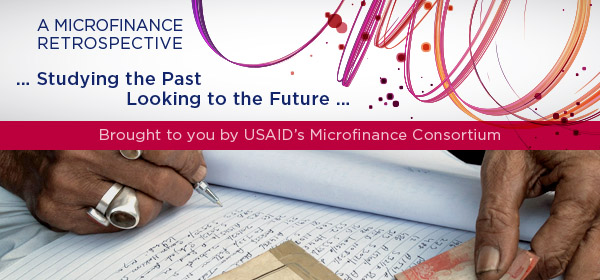Studying the Past, Looking to the Future: Why Was It Called The Office of Microenterprise Development?

If It Was Focused on Finance, Why Was It Called The Office of Microenterprise Development?
The USAID Office of Microenterprise Development was created in 1994 with the launch of the Microenterprise Initiative. The Office had a mission: build self-sustaining financial institutions that reached poor households. Having just joined the Office, led by Elisabeth Rhyne, this seemed to me like the beginning of a great, new effort to support the enterprises of the very poor and increase their access to financial services. What I soon discovered was that this work wasn’t new at all, it was already two decades old.
In the late 60s and early 70s, USAID was looking for a way to address poverty.
In 1972 the USAID Urban Development Office convened a workshop of development experts to address urban poverty. Among them were John Friedman and Flora Sullivan who presented a paper that identified the “family enterprise sector.” These businesses had 10 or fewer employees, including unpaid family workers. They argued that this category of small household businesses could have the capacity to employ 35 to 45 percent of the urban labor force if their productivity could be increased.
At the same time the International Labor Organization (ILO) was seeking to understand employment in developing countries. An ILO study of employment in Kenya first used the term “informal sector” to describe the small-scale businesses operated by low-income households. These were enterprises that were often harassed and forced to pay bribes. Their only access to capital was family members and friends and usurious money lenders.
In 1977 the USAID Office of Urban Development asked Simon Fass, then an urban planner with a United Nations project in Haiti, to prepare a study that described how low-income families in Port-au-Prince produced earnings from their household business activities.
These were enterprises so small they did not show up on an official business census. Their owners were seriously entrepreneurial, yet due to their lack of working capital and other resources, the enterprises would always remain small and even precarious.
The evidence was clear and coming from a number of countries - poor people were economically active, and their economic efforts were a significant part of the economy. Unfortunately by operating under the radar, these enterprises did not have access to capital and the resources they needed to grow.
Today we may take for granted the economic role of microenterprises and their place in a development program. But at the time these first studies and discussions were underway, development efforts were focused heavily on large firms in an effort to increase GDP through import substitution.
The microfinance programs that emerged in the 1990s had their roots in early efforts to reduce poverty by increasing microenterprise access to financing as a way to promote growth and generate employment for the poor. At the time it was believed that if microenterprises had access to finance, they would absorb labor, grow into small enterprises, and fuel economic growth. We now know that even if microenterprises don’t grow (and they often do not), the revenue they generate is crucial to meeting family needs for essential goods and services.
These small businesses also provide convenient access to products and services in low-income neighborhoods, playing an important role within the community.
We recognize that loans to families may not be invested in a family business, but might be used directly to feed families, buy medicine, and send kids to school. That’s why the term “microfinance” has come to replace the term “microenterprise finance” and why access to financial services now goes far beyond a focus on enterprises.

